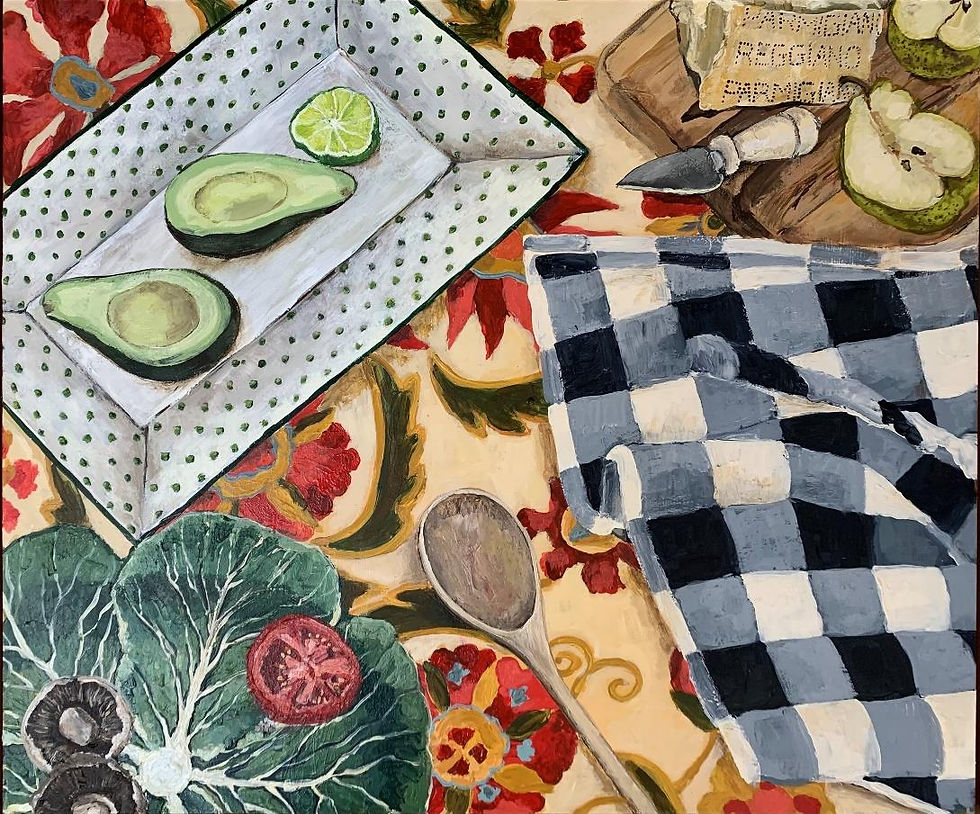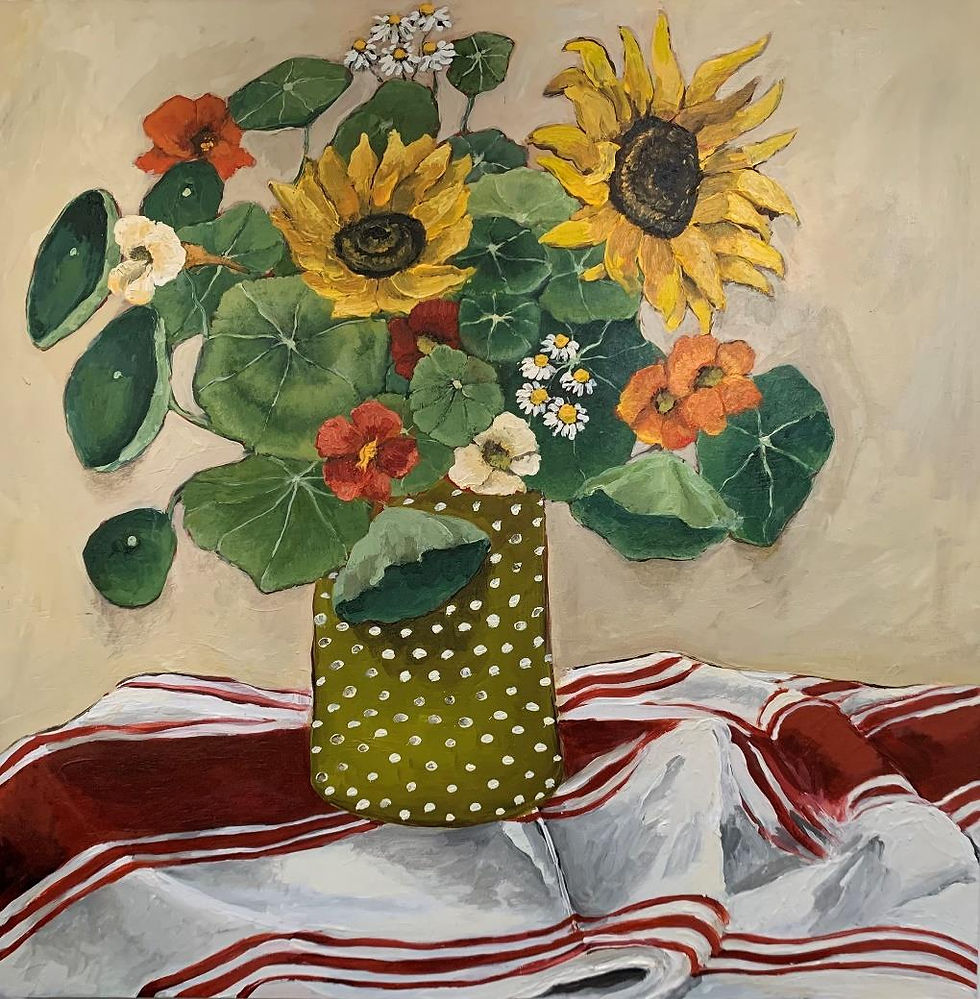
ANNA PLACIDI
HOPE SPRINGS

43 x 38cm Impasto and Acrylic on Birch Panel. $1550

43 x 38cm Impasto and Acrylic on Birch Panel. $1550

24 x 33cm Impasto and Acrylic on Birch Panel. $950

33 x 24cm Impasto and Acrylic on Birch Panel. $950

63 x 45cm Impasto and Acrylic on Birch Panel. $1950

50 x 37cm Impasto and Acrylic on Birch Panel. $1650

53 x 63cm Impasto and Acrylic on Birch Panel. $2100

37 x 50cm Impasto and Acrylic on Birch Panel. $1650

24 x 33cm Impasto and Acrylic on Birch Panel. $950

53 xc 53cm Impasto and Acrylic on Birch Panel. $1950

33 x 45cm Impasto and Acrylic on Birch Panel. $1450

24 x 33cm Impasto and Acrylic on Birch Panel. $950

37 x 50cm Impasto and Acrylic on Birch Panel. $1650
Anna Placidi
Our yearning for the petal that never perishes and the jug that is always brimming is embodied in the tradition of the painted bouquet. It has come to be seen as a traditional form, but it would be a mistake to judge the still life solely as a static genre. Flowers and fruit are fertile ground for radical creativity. In the right hands the simplest of forms are re-invented and forged anew. Cezanne did this by tilting the picture plane to gently tumble the view. Van Gogh enlarged his blooms to give them the frontal intensity of portraits and Matisse turned table tops into landscapes, each object replete with their own mystic symbolism. A solid painting of a vase or bowl has the power to draw you in and hold you, transfixed. The secret of the greatest still life paintings also dwells in their self-possession. The art, I suppose, of everything being given its own weight and importance, the idea that each flower is an entity as singular as a human face.
Anna Placidi is alert to the magnetism of small and quiet things. Her process is patient and uncontrived, allowing each form to speak as their conventions dissolve. Immersed in her studio garden and the swaying buds that brush past her legs on long winter walks, Placidi gives powerful sentience to the natural world of her home in Ballarat:
““For me, each flower has a soul. And I can spend up to one day on each one, giving it its due. The daffodils in my new works were demanding. I dove into each one, almost drilling into their core.”
As a result, her still life paintings pulse with an absorbing immediacy and take on an almost sculptural presence. The energy of her palette is built up through an accretion of colour. Veiled beneath her final coats of charcoal, Naples yellow or pale grey are unknown layers of tangerine and vermillion, the undercoats that make her canvas purr and glow.
In this new collection of work, the artist returns to the varieties that compel her: bruised and earthy Pansies, winding Nasturtiums and the Daffodil, a flower rich in private meaning:
“Near my house is a field of Daffodils. When I recovered from a serious illness one August, I went to this paddock and lay down in a sea of swaying stems and nodding flowers. The Daffodil remains for me such a hopeful flower. For me they mean renewal.”
Completed over five months, this series of paintings took on an earthy hue. In the pale winter sunlight the painter’s eye sharpened, drawn to meticulous detail and the raw promise of moss and shooting stems. Though vivid, Placidi admits that not every painting is a seasonal truth. For “The Daffodil Collector” she could not source the particular ragged ones with ruffled orange hearts. Some of the flowers she paints are at hand and others are from memory. Her mission not a realist quest or an obedient act. This said, each painting is true to its time, the conditions of light and the shifting atmosphere of a studio embedded in the heart of her home.
Some of the paintings came to fruit at night. These ones possess an enclosed sense of privacy and she admits that in the depths of a Victorian winter her palette deepens and darkens. Some of her titles allude to Spring and their blossoms sit upon its cusp, a potent symbol of dormant energies unfurling. The idea of confined space and coiled release is revealed in their unusual geometry. Compositionally the works fill the frame like a family filling a room, every corner taken;
“These works were not solely lockdown paintings. But certainly, their atmosphere is concentrated, sort of compressed with yearning. I admit there is a desire for travel in there, a sense of escape through treasured objects and memory. My love for Italy is expressed in favourite rustic vases, my table-scapes look like summer and I create different tableaus for each painting depending on the flower.”
Optimism suffuses their surface in a palette of mineral winter skies and mottled hues of old terracotta pots. Exploring these cracked faithful vessels, Placidi is at her most painterly, pushing into the tonal wealth of clay from Sienna to Violet. Created slowly in impasto layers each painting has a distinct emotional tenor. Some are stubbornly cheerful while others more introspective and ambiguous. And though this painter is known for her signature objects: lemons, cutlery and the ragged linear play of rumpled tablecloths, each series signals a subtle change. Seen as a body of work, these are studies of patience and the sheer weight of expectant time. Placidi’s work pushes into new turf while following a steady cycle of return. Her focus is attuned to our emotional dependence on the vulnerable strength of plants. As with every seed we bury faith and on the slender shoulders of flowers, we place our dreams.
“I can’t explain my focus upon flowers and living things. In light of some hard years, it just inspiring to know that the trees and stems follow their cycle. They don’t know of changing rules because they follow their own pattern. I think we love flowers because we know they will open, and that promise of renewal is hope.”
Anna Johnson
